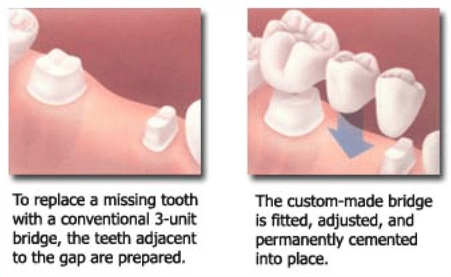Why replace a missing tooth?
In a normal, healthy mouth, chewing function is well balanced since each upper tooth has proper contact and function with corresponding lower teeth. Because of this natural proper balance, undue strain or irritation on the gum tissue and bone is non-existent. Drifting or spreading of teeth does not occur and oral hygiene is easily maintained. But, this natural proper balance is quickly destroyed when a tooth is lost.
This is what can happen :
- The opposing molar may Supra-erupt.
- The unprotected ridge is subject to trauma.
- The adjacent teeth tilt and proper functional balance is destroyed.
- The drifting teeth create food impact areas where decay starts
- or where Periodontal Disease can start.
- Destruction to the bone will result as teeth drift and tip.
A dental crown may be advised to:
- protect a weak tooth (for instance, from decay) from breaking especially after an RCT
- restore an already broken tooth or a tooth that has been severely worn down.
- cover and support a tooth with a large filling when there isn't a lot of tooth left
- hold a dental bridge in place
- cover misshaped or severely discolored teeth
- over a dental implant
Dental bridges are meant to replace missing teeth by "bridging" the gap between two remaining teeth. This involves creation of a pontic, or false tooth's with a dental crown on either side. The crowns are fitted over the remaining teeth to hold the false tooth in place.
When there are only teeth on one side of the gap, cantilever bridges may be given. cantilever bridges consist of two side-by-side crowns and only one is connected to the pontic.

